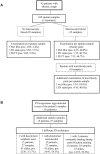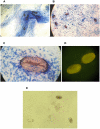Ziehl-Neelsen staining technique can diagnose paragonimiasis
- PMID: 21610861
- PMCID: PMC3096611
- DOI: 10.1371/journal.pntd.0001048
Ziehl-Neelsen staining technique can diagnose paragonimiasis
Abstract
Background: We evaluated the Ziehl-Neelsen staining (ZNS) technique for the diagnosis of paragonimiasis in Laos and compared different modifications of the ZNS techniques.
Methodology: WE APPLIED THE FOLLOWING APPROACH: We (1) examined a paragonimiasis index case's sputum with wet film direct examination (WF) and ZNS; (2) re-examined stored ZNS slides from two provinces; (3) compared prospectively WF, ZNS, and formalin-ether concentration technique (FECT) for sputum examination of patients with chronic cough; and (4) compared different ZNS procedures. Finally, we assessed excess direct costs associated with the use of different diagnostic techniques.
Principal findings: Paragonimus eggs were clearly visible in WF and ZNS sputum samples of the index case. They appeared brownish-reddish in ZNS and were detected in 6 of 263 archived ZNS slides corresponding to 5 patients. One hundred sputum samples from 43 patients were examined with three techniques, which revealed that 6 patients had paragonimiasis (13 positive samples). Sensitivity per slide of the FECT, ZNS and the WF technique was 84.6 (p = 0.48), 76.9 (p = 0.25) and 61.5% (p = 0.07), respectively. Percentage of fragmented eggs was below 19% and did not differ between techniques (p = 0.13). Additional operational costs per slide were 0 (ZNS), 0.10 US$ (WF), and 0.79 US$ (FECT). ZNS heated for five minutes contained less eggs than briefly heated slides (29 eggs per slide [eps] vs. 42 eps, p = 0.01). Bloodstained sputum portions contained more eggs than unstained parts (3.3 eps vs. 0.7 eps, p = 0.016).
Conclusions/significance: Paragonimus eggs can easily be detected in today's widely used ZNS of sputum slides. The ZNS technique appears superior to the standard WF sputum examination for paragonimiasis and eliminates the risk of tuberculosis transmission. Our findings suggest that ZNS sputum slides should also be examined routinely for Paragonimus eggs. ZNS technique has potential in epidemiological research on paragonimiasis.
Conflict of interest statement
The authors have declared that no competing interests exist.
Figures


References
-
- Narain K, Devi KR, Mahanta J. Pulmonary paragonimiasis and smear-negative pulmonary tuberculosis: a diagnostic dilemma. Int J Tuberc Lung Dis. 2004;8:621–622. - PubMed
-
- Odermatt P, Habe S, Manichanh S, Tran DS, Duong V, et al. Paragonimiasis and its intermediate hosts in a transmission focus in Lao People's Democratic Republic. Acta Trop. 2007;103:108–115. - PubMed
-
- Strobel M, Veasna D, Saykham M, Wei Z, Tran DS, et al. La paragoniomose pleuropulmonaire. Med Mal Infect. 2005;35:476–481. - PubMed
-
- Belizario V, Guan M, Borja L, Ortega A, Leonardia W. Pulmonary paragonimiasis and tuberculosis in Sorsogon, Philippines. Southeast Asian J Trop Med Public Health. 1997;28(Suppl 1):37–45. - PubMed
Publication types
MeSH terms
LinkOut - more resources
Full Text Sources

